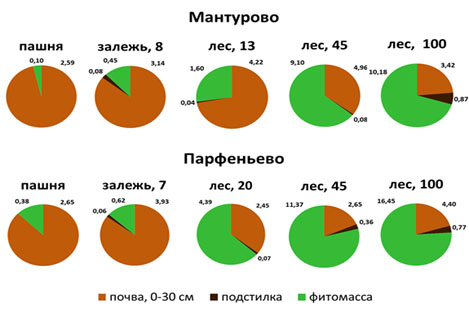Dynamic of carbon pools in the postagrogenic ecosystems of the southern taiga
DOI:
https://doi.org/10.31251/pos.v7i3.272Keywords:
succession; arable land; haymaking land; soil organic matter; Albic Retisol; Retic Albic Podzol; podzols; soddy-podzolic soils.Abstract
The aim of the study was to assess the nature of changes in the main carbon pools of ecosystems during post-agrogenic vegetation restoration for different agricultural lands.
Location and time of the study. The research was carried out in the Kostroma region. The objects are chronosequences, representing overgrown arable land, hayfield, hayfield-pasture and a well-fertilized private garden.
Methods. The biomass of forest stand was calculated allometrically; the biomass of living ground plant cover was calculated using the method of cuttings (aboveground) and monoliths (underground). Soil organic carbon content was determined by dichromate digestion, and soil microbial biomass was assessed by substrate-induced respiration.
Results. During succession in arable lands and hayfields, an increase in ecosystem carbon reserves was revealed due to the growth of woody phytomass, the share of carbon reserves growing from 0–10 to 65–78% over 40–50 years. When fertilized vegetable gardens become overgrown within 35 years, there was no regeneration of the tree stand. The upper horizons of arable soils contained 0,83–1,05% organic carbon, whreas the soil of the hay and the hay-pasture meadows contained 2,25% and 3,97%, respectively, and the soil of a vegetable garden contained 4,89%. When arable land is overgrown, carbon reserves in the old arable layer increased from 2,0–2,6 to 3,0–5,0 kg C/m2; when the hay meadow is overgrown, soil organic carbon stock decreased from 5,2 to 4,8 kg C/m2; in the hayfield-pasture, it decreased by 3,8 times; in the vegetable gardens, the carbon stock (10 kg C/m2) remained virtually unchanged for 35 years.
Conclusions. When reforesting arable lands, as well as hayfields in the absence of livestock grazing, ecosystem carbon reserves increased 4–7 times with a decrease in the soil carbon share. The direction and nature of the carbon pools dynamics is determined by the soil humus state at the beginning of succession and, as a consequence, the type of use.
Downloads

Downloads
Published
How to Cite
Issue
Section
License
Copyright (c) 2024 The Journal of Soils and Environment

This work is licensed under a Creative Commons Attribution 4.0 International License.






